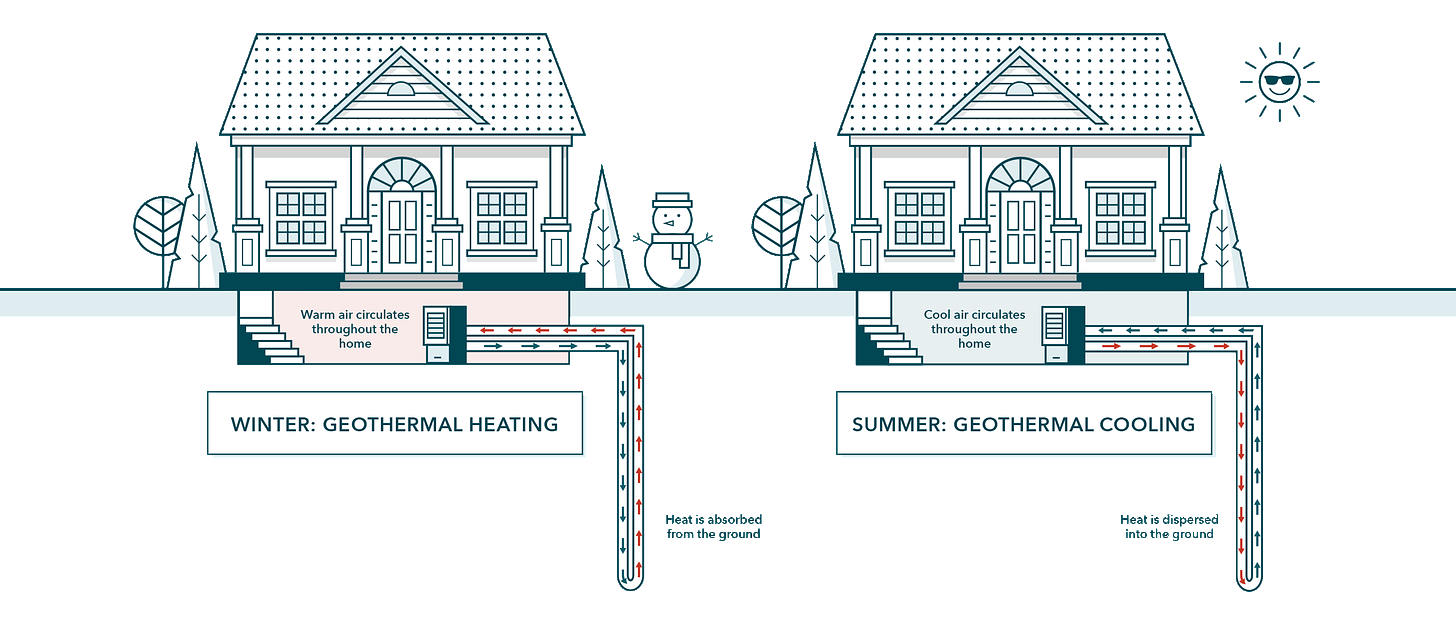The biggest emission of carbon dioxide (CO2) for a typical household is originating from the heating and cooling of the home, even the best-insulated homes, need an efficient heating and cooling system. One of the most efficient ways to do this is by using a geothermal heat pump, but this technology hasn’t quite seen the same adoption and innovation that e.g. photovoltaic panels have. The people at Dandelion Energy think that they have what it takes to popularize this technology and unlock it for use in the residential market.
👽 What?
Dandelion Energy produces and installs water-to-air closed-loop geothermal heat pumps. Geothermal systems work by circulating temperature-conducting fluid through an underground loop of pipes to collect the thermal energy in the earth. In the winter the system extracts heat from the ground, while in the summer heat is dispersed back into the ground. The thermal energy is transformed into useful energy by a ground source heat pump or GHSP.
While the name geothermal might lead you to believe otherwise, GHSPs don’t really use the warmth coming from the core of the earth. Dandelion only drills 150 m deep, to notice a meaningful increase in temperature you would need to drill in most cases up to 1 km deep. Drilling this deep is called direct use or non-electrical use geothermal and is only feasible for electricity generation or district heating projects. Instead, with a ground source heat pump what matters is the squared footage of the pipeline that is exposed to the earth and the type of soil that it is exposed to.
imagery courtesy Dandelion Energy
This base technology isn’t innovative by any stretch of the imagination. The first geothermal power plant was already constructed in 1911 and in the 1940s the first version of a GHSP was implemented. So not exactly what you would expect to read about in a #proptech newsletter, but what makes Dandelion Energy interesting are a number of innovations that are applied on top of the existing solutions, like geothermal system design software, purpose-built equipment, integrated processes, and built-in financing, that make the use of the technology more attainable and cost-effective for residential use.
🤷 Who?
Dandelion Energy was started as a moonshot at X, “the innovation engine of Alphabet/Google.” In 2017 Dandelion Energy became an independent company led by Kathleen Hannun and James Quazi. In 2020 Michael Sachse was brought on as CEO. Coming out of X, certainly had no issue finding funding and already raised more than $64M in funding with ao. GV (Google ventures) and Collaborative Fund. At the moment Dandelion is focussing on the retrofitting market replacing existing gas or petroleum-based heating systems, but they started a partnership with Lennar Corporation, one of the biggest home builders in the US, and plan to develop an offering together.
🕵️♀️ Who else?
Traditionally how the industry works is that the ground source heat pumps are manufactured by companies like Vaillant, WaterFurnace, or Bosh, they are installed by a local HVAC installer while the ground loops are installed by a drilling subcontractor. Dandelion Energy is unique in the fact that they combine these services into one company and provide the financing for the project on top.
👍 Why
Dandelion Energy provides a low-carbon heating alternative with a relatively low need for electrical power. Replacing fossil fuels with, in most cases, electricity-based solutions will have a big impact on the infrastructure and the electricity that needs to be generated to fulfill all these functions. Having a highly efficient way to produce heat will be essential in phasing out our oil and gas dependency.
Next to the fact that over the long term it’s more cost-effective, you also remove the risks associated with a boiler like Co2 poisoning, gas explosions, ….
👎 Why not?
You might worry about the impact extracting heat from the soil might have, but the amount of energy that’s needed to heat your home is tiny compared to the amount that is available.
The drilling might have an impact on the stability of your existing building, but because of the usage of specialized equipment and the small footprint of drilling these risks should be minimal.
📚 Further reading?
TechCrunch: Geothermal home heating gets a boost
Dandelion Compared to competitors
Vox on Carbon-free heat for buildings
✨ Giphty
If Dandelion seems still too expensive, you could still DIY your own geothermal installation!




